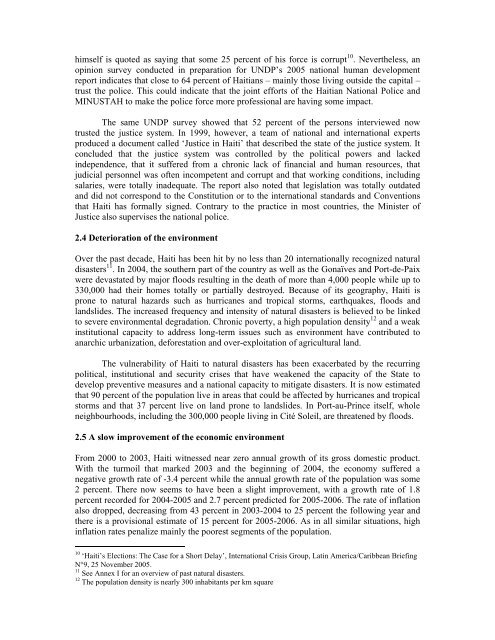case study Haiti - United Nations Development Programme
case study Haiti - United Nations Development Programme
case study Haiti - United Nations Development Programme
Create successful ePaper yourself
Turn your PDF publications into a flip-book with our unique Google optimized e-Paper software.
himself is quoted as saying that some 25 percent of his force is corrupt 10 . Nevertheless, an<br />
opinion survey conducted in preparation for UNDP’s 2005 national human development<br />
report indicates that close to 64 percent of <strong>Haiti</strong>ans – mainly those living outside the capital –<br />
trust the police. This could indicate that the joint efforts of the <strong>Haiti</strong>an National Police and<br />
MINUSTAH to make the police force more professional are having some impact.<br />
The same UNDP survey showed that 52 percent of the persons interviewed now<br />
trusted the justice system. In 1999, however, a team of national and international experts<br />
produced a document called ‘Justice in <strong>Haiti</strong>’ that described the state of the justice system. It<br />
concluded that the justice system was controlled by the political powers and lacked<br />
independence, that it suffered from a chronic lack of financial and human resources, that<br />
judicial personnel was often incompetent and corrupt and that working conditions, including<br />
salaries, were totally inadequate. The report also noted that legislation was totally outdated<br />
and did not correspond to the Constitution or to the international standards and Conventions<br />
that <strong>Haiti</strong> has formally signed. Contrary to the practice in most countries, the Minister of<br />
Justice also supervises the national police.<br />
2.4 Deterioration of the environment<br />
Over the past decade, <strong>Haiti</strong> has been hit by no less than 20 internationally recognized natural<br />
disasters 11 . In 2004, the southern part of the country as well as the Gonaïves and Port-de-Paix<br />
were devastated by major floods resulting in the death of more than 4,000 people while up to<br />
330,000 had their homes totally or partially destroyed. Because of its geography, <strong>Haiti</strong> is<br />
prone to natural hazards such as hurricanes and tropical storms, earthquakes, floods and<br />
landslides. The increased frequency and intensity of natural disasters is believed to be linked<br />
to severe environmental degradation. Chronic poverty, a high population density 12 and a weak<br />
institutional capacity to address long-term issues such as environment have contributed to<br />
anarchic urbanization, deforestation and over-exploitation of agricultural land.<br />
The vulnerability of <strong>Haiti</strong> to natural disasters has been exacerbated by the recurring<br />
political, institutional and security crises that have weakened the capacity of the State to<br />
develop preventive measures and a national capacity to mitigate disasters. It is now estimated<br />
that 90 percent of the population live in areas that could be affected by hurricanes and tropical<br />
storms and that 37 percent live on land prone to landslides. In Port-au-Prince itself, whole<br />
neighbourhoods, including the 300,000 people living in Cité Soleil, are threatened by floods.<br />
2.5 A slow improvement of the economic environment<br />
From 2000 to 2003, <strong>Haiti</strong> witnessed near zero annual growth of its gross domestic product.<br />
With the turmoil that marked 2003 and the beginning of 2004, the economy suffered a<br />
negative growth rate of -3.4 percent while the annual growth rate of the population was some<br />
2 percent. There now seems to have been a slight improvement, with a growth rate of 1.8<br />
percent recorded for 2004-2005 and 2.7 percent predicted for 2005-2006. The rate of inflation<br />
also dropped, decreasing from 43 percent in 2003-2004 to 25 percent the following year and<br />
there is a provisional estimate of 15 percent for 2005-2006. As in all similar situations, high<br />
inflation rates penalize mainly the poorest segments of the population.<br />
10 ‘<strong>Haiti</strong>’s Elections: The Case for a Short Delay’, International Crisis Group, Latin America/Caribbean Briefing<br />
N°9, 25 November 2005.<br />
11 See Annex I for an overview of past natural disasters.<br />
12 The population density is nearly 300 inhabitants per km square

















